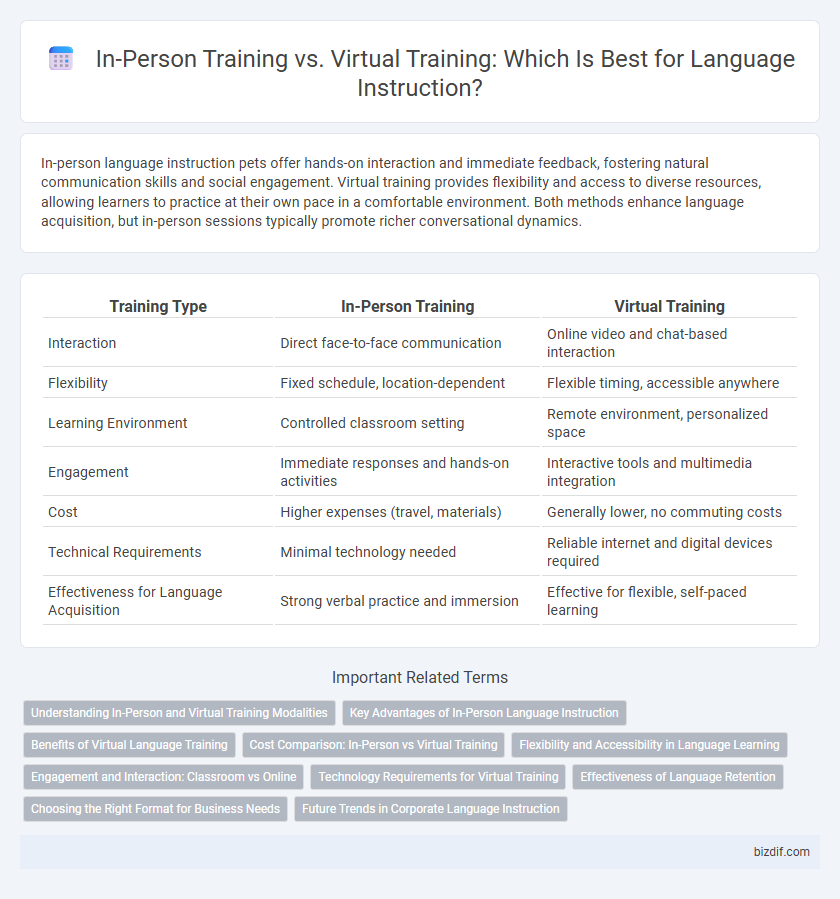In-person language instruction pets offer hands-on interaction and immediate feedback, fostering natural communication skills and social engagement. Virtual training provides flexibility and access to diverse resources, allowing learners to practice at their own pace in a comfortable environment. Both methods enhance language acquisition, but in-person sessions typically promote richer conversational dynamics.
Table of Comparison
| Training Type | In-Person Training | Virtual Training |
|---|---|---|
| Interaction | Direct face-to-face communication | Online video and chat-based interaction |
| Flexibility | Fixed schedule, location-dependent | Flexible timing, accessible anywhere |
| Learning Environment | Controlled classroom setting | Remote environment, personalized space |
| Engagement | Immediate responses and hands-on activities | Interactive tools and multimedia integration |
| Cost | Higher expenses (travel, materials) | Generally lower, no commuting costs |
| Technical Requirements | Minimal technology needed | Reliable internet and digital devices required |
| Effectiveness for Language Acquisition | Strong verbal practice and immersion | Effective for flexible, self-paced learning |
Understanding In-Person and Virtual Training Modalities
In-person training offers immersive, face-to-face interaction that enhances communication through body language and immediate feedback, fostering deeper learner engagement. Virtual training provides flexible, accessible learning experiences with multimedia resources and real-time collaboration tools, supporting diverse learning styles and geographic independence. Understanding these modalities enables tailored instructional design to maximize knowledge retention and learner satisfaction.
Key Advantages of In-Person Language Instruction
In-person language instruction offers immersive interaction that enhances conversational skills and immediate feedback, fostering rapid improvement. The physical classroom environment supports better engagement through non-verbal cues and group dynamics, which are crucial for language acquisition. Access to hands-on learning materials and personalized teacher support further solidifies comprehension and retention in students.
Benefits of Virtual Language Training
Virtual language training offers flexible scheduling and accessibility, allowing learners to participate from any location with internet access. Interactive tools such as real-time quizzes, video conferencing, and digital flashcards enhance engagement and retention. Cost savings are significant due to the elimination of travel expenses and physical classroom requirements.
Cost Comparison: In-Person vs Virtual Training
In-person training typically incurs higher costs due to expenses such as venue rental, travel, accommodation, and printed materials, which can significantly impact budget allocation. Virtual training reduces overhead costs by eliminating physical space requirements and travel expenses, allowing for more scalable and flexible delivery. Organizations seeking cost efficiency often prefer virtual training platforms that leverage digital resources and minimize logistical expenditures.
Flexibility and Accessibility in Language Learning
In-person language training offers structured schedules and direct interaction, enhancing real-time communication skills but may limit flexibility for learners with busy or irregular commitments. Virtual training provides greater accessibility, allowing learners to access materials anytime and anywhere, accommodating diverse time zones and personal schedules. The blend of synchronous and asynchronous virtual classes maximizes flexibility while maintaining interactive elements essential for effective language acquisition.
Engagement and Interaction: Classroom vs Online
In-person language training fosters higher engagement through direct, real-time interaction, allowing instant feedback and dynamic group activities that enhance conversational skills. Virtual training offers flexibility but often struggles with maintaining participant attention due to screen fatigue and limited physical cues. Effective virtual platforms integrate interactive tools like breakout rooms, polls, and real-time chat to simulate in-class dynamics and boost learner interaction.
Technology Requirements for Virtual Training
Virtual training demands robust technology infrastructure, including high-speed internet, compatible devices, and reliable video conferencing software to ensure seamless communication and engagement. Advanced features like screen sharing, breakout rooms, and interactive tools enhance learner participation and content delivery. Consistent technical support is essential to address connectivity issues promptly, minimizing disruptions and maintaining an effective learning environment.
Effectiveness of Language Retention
In-person training enhances language retention through immersive, face-to-face interactions that facilitate immediate feedback and real-time conversational practice. Virtual training offers flexible, self-paced learning environments but may limit spontaneous communication and reduce long-term retention without active engagement strategies. Research indicates that combining in-person and virtual methods often yields the highest effectiveness in language retention.
Choosing the Right Format for Business Needs
In-person training fosters direct interaction and hands-on practice, enhancing engagement and immediate feedback crucial for complex language skills. Virtual training offers flexibility, scalability, and cost-effectiveness, accommodating diverse schedules and remote teams while utilizing interactive digital tools. Selecting the right format depends on business goals, employee location, learning preferences, and budget constraints to maximize language acquisition and productivity.
Future Trends in Corporate Language Instruction
Future trends in corporate language instruction emphasize a blend of in-person training and virtual learning environments to enhance engagement and adaptability. Technological advancements such as AI-driven personalized language platforms and immersive VR experiences are shaping tailored learning paths and real-world communication simulations. Data analytics and real-time feedback tools are increasingly integrated to optimize learner outcomes and track progression effectively.
In-person training vs Virtual training Infographic

 bizdif.com
bizdif.com